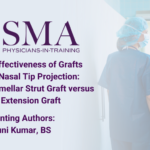Abstract | May 4, 2021
Safety and Effectiveness of Grafts to Increase Nasal Tip Projection: Comparing Columellar Strut Graft versus Septal Extension Graft
Learning Objectives
- Upon completion of this lecture, learners should be better prepared to compare the prevalence of postoperative complications between patients receiving columellar strut grafts and septal extension grafts.
Background/Knowledge Gap:
In surgical rhinoplasty, there are three key parameters that plastic surgeons must take into account: nasal tip projection, length, and rotation. In many congenital or post-traumatic deformity cases, increasing nasal tip projection is essential for both nasal functioning and visual aesthetics. Two common grafts used to increase nasal tip projection are columellar strut graft and septal extension graft. There is a lack of high-level evidence found on determining which grafts are safe and effective at increasing nasal tip projection. The purpose of this study is to review and evaluate the safety and effectiveness of two commonly used grafts, columellar strut graft and septal extension graft.
Methods/Design:
A review of PubMed, Embase, and Web of Science was performed according to Preferred Reporting Items for Systematic Review and Meta-Analyses guidelines. All English-language studies presenting findings on increasing nasal tip projection in surgical rhinoplasty published between 2000 to 2020 were included. We excluded any interventions that did not use columellar strut graft or septal extension graft, literature reviews/letters/commentaries, and non-human or cadaver studies. A total of 1919 patients enrolled in 33 studies were included in our review.
Results/Findings:
Thirty-three qualified studies were included, with a total of 1919 patients of which 1336 patients received columellar strut graft and 583 received septal extension graft for increasing nasal tip projection. We found that 150 patients suffered post-operative complications (Table 1). Eighty-eight patients suffered complications after receiving columellar strut graft [88 of 1336 (6.6%)] of which 84 patients suffered simple contour irregularity [84 of 1336 (6.3%)]. Sixty-two patients suffered complications after receiving septal extension graft [62 of 583 (10.6%)] of which 19 patients suffered tip or nostril asymmetry [19 of 583 (3.3%)] and 14 patients suffered columella stiffness or excessive showing of the columella [14 of 583 (2.4%)]. We also found that with increasing nasal tip projection, 95.5% of patients were highly satisfied or satisfied with the results after using columellar strut graft and 95.2% of patients were highly satisfied or satisfied after using septal extension graft.
Conclusion/Implications:
Columellar strut graft and septal extension grafts are safe and effective grafts for increasing nasal tip projection. Columellar strut graft for nasal tip projection may be safer and slightly more effective than septal extension grafts. However, further prospective studies should be conducted to explore the differences and underlying mechanisms in patient satisfaction and safety for increasing/maintaining nasal tip projection in surgical rhinoplasty.

